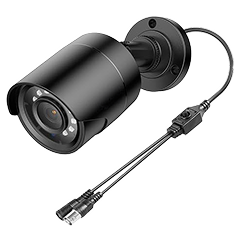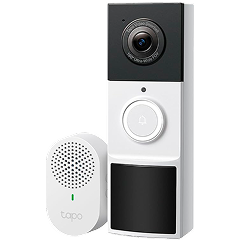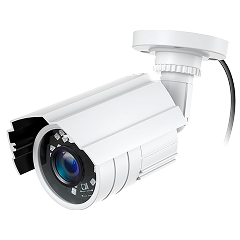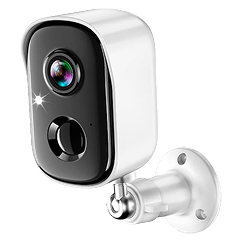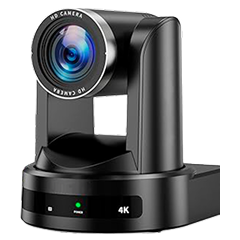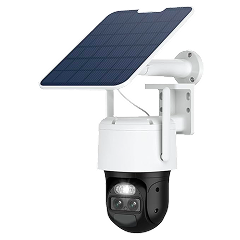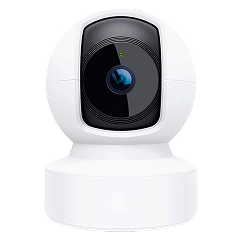Llevo tres años usando cámaras Ring en mi propiedad y tengo la intención de mejorar a un sistema UniFi en el futuro. En este tiempo, he comprobado que las cámaras de seguridad inalámbrica resuelven problemas distintos a los sistemas con cable, pero también tienen sus inconvenientes.
Como ingeniero que valora tanto el rendimiento como la comodidad, me decanté por un sistema inalámbrico como mi primer equipo porque así podía instalar las cámaras donde quisiera sin tener cables por las paredes. Gracias al sistema Ring, supe lo que funciona bien (buena duración de la batería en climas templados y un buen sistema de detección de movimientos) y lo que no funciona tan bien (streaming en 4K por wifi en las horas de máximo uso o las cargas solares en invierno).
En esta guía nos centraremos en las cuestiones relacionadas con las cámaras inalámbricas que la mayoría de los consejos de seguridad que hay en Internet pasan por alto: cómo afecta la saturación de la wifi a la calidad de vídeo, por qué el rendimiento de la batería varía tanto con respecto a lo que aseguran los proveedores y cómo plantear un sistema que funcione de manera fiable.
Aunque no me dedico a la instalación de sistemas de seguridad, he cometido suficientes errores con mi propia instalación para saber qué preguntas deberías hacerte antes de comprar. Si quieres saber más sobre cuestiones básicas de las cámaras de vigilancia, como los estándares de resolución, o ver una comparativa entre fabricantes, te sugiero leer nuestra guía principal.
Calidad y resolución de vídeo: Qué es lo importante a la hora de identificar
Ninguna compañía te va a decir que el wifi puede estropear el vídeo o qué resolución necesitas.
4K vs. 1080p: diferencia de rendimiento en casos reales
Mis cámaras Ring tienen una resolución de 1080p, con la que puedo identificar caras a unos 4,5 m y captar matrículas a unos 7,5 m si la luz es adecuada. Aunque pasar a 4K suena tentador, debes saber que triplica el uso del ancho de banda y consume mucha más batería.
De hecho, he probado modelos en 4K cuya batería apenas duró dos meses en comparación con los seis meses de los modelos en 1080p. A menos que necesites abarcar una zona muy amplia que requiera un zoom digital a objetos lejanos, la resolución de 1080p muestra todos los detalles necesarios sin afectar tanto al rendimiento de la red.
Calidad de visión nocturna y rendimiento de los LED infrarrojos
La calidad de la visión nocturna varía mucho de un modelo a otro y la cantidad de LED infrarrojos no sirve mucho para determinarla. Las cámaras reflectoras Ring que utilizo cuentan con ocho LED infrarrojos, pero solo iluminan unos 6 m de manera eficaz. A partir de ahí, la imagen se muestra demasiado granulada como para identificar objetos o figuras.
El posicionamiento de los LED es más importante que la cantidad de LED. Las cámaras cuyas luces se propagan por las lentes ofrecen una cobertura de más calidad que los modelos que agrupan toda luz en un solo punto. La visión nocturna con color luce genial en las demostraciones, pero debe haber luz para que funcione, por eso te sugiero usar los infrarrojos estándar para situaciones de oscuridad reales.
Limitaciones del zoom digital e impacto de la compresión
Las cámaras inalámbricas dependen mucho del zoom digital, ya que los mecanismos de zoom óptico agotan la batería y son más complejos. El problema es que el zoom digital básicamente aumenta los píxeles, por lo que si una cara es irreconocible en la imagen original, no se va a mostrar clara por arte de magia al hacer zoom. Además, la compresión agrava el problema.
Las cámaras Ring que utilizo tienen codificación H.264, que ya de por sí descarta ciertos detalles para reducir el tamaño del archivo para la transmisión inalámbrica. Así pues, si quieres identificar a alguien a más de 10 m, deberías acercar la cámara en lugar de depender de las funciones de zoom.
Conectividad inalámbrica y requisitos de la red
Tras instalar las cámaras de vigilancia inalámbricas, tu red lleva el peso de todo el sistema de seguridad y los usuarios siempre infravaloran cuánto ancho de banda consumen estos aparatos. De hecho, es algo que descubrí de primera mano cuando las tres cámaras Ring que tengo empezaron a perder fotogramas o frames durante la cena, ya que todo el mundo estaba viendo vídeos en streaming.
Estas cámaras no necesitan cables y al conectarse a la wifi compiten con teléfonos, PC y cualquier dispositivo de streaming que consuma datos de la red inalámbrica.
Las cámaras con WiFi 6 gestionan mejor esta competencia por los datos que los dispositivos con WiFi 5, sobre todo si hay varias cámaras en funcionamiento. De hecho, mi dispositivo Ubiquiti Dream Machine gestiona mejor la cantidad que mi antiguo router. Pero, aun teniendo un equipo de nivel empresarial, la calidad de imagen se reduce al grabar con las tres cámaras al mismo tiempo.
Aunque la banda de 5GHz ofrece un rendimiento superior para las cámaras, el rango se ve afectado. Por ejemplo, tuve que mantener la banda 2.4GHz para la cámara que tengo en el garaje porque la señal de 5GHz apenas llegaba.
Consideraciones de red clave para un sistema de cámaras inalámbricas:
- Cuenta con entre 2 y 4 Mbps de ancho de banda de subida para la grabación de una cámara de 1080p.
- Posiciona la cámara en un zona con un buen rango para 5GHz siempre que sea posible (por lo general, a menos de 15 m si hay paredes en medio).
- Evita instalar más de 3 o 4 cámaras inalámbricas con un solo punto de acceso.
- Comprueba la velocidad de subida en la ubicación de cada cámara, no solo la velocidad de bajada.
- Plantéate usar nodos mesh si tu propiedad tiene zonas muertas para la wifi.
- Supervisa la posible saturación de la red en las horas de máximo uso antes de elegir la ubicación de la cámara de manera definitiva.
Gestión de la energía: duración de la batería y opciones solares
El rendimiento de la batería en las cámaras inalámbricas rara vez encaja con las cifras que asegura el fabricante. Además, la temperatura es lo que más rápido agota la batería. Las baterías de las cámaras Ring que tengo (y que ya usaba en mi anterior casa) deberían durar seis meses por carga, pero en realidad, duraron cuatro meses en primavera y otoño, tres meses en verano y apenas dos en invierno, cuando la temperatura cae bajo cero.
La frecuencia del movimiento también importa. La cámara frontal de mi casa agotaba la batería el doble de rápido que la cámara del patio porque se activaba más veces debido al paso de transeúntes y a los camiones de reparto.
Los paneles solares ayudan, pero no son una solución mágica como los fabricantes te hacen creer. En mi caso, añadí un panel solar a la cámara que más se activaba porque ya estaba cansado de cambiarle la batería todos los meses y lo cierto es que funcionó bien de abril a septiembre. Pero en los meses de invierno, cuando los días duran menos y el cielo se nubla más, el panel solar apenas mantuvo el nivel de la batería, así que ni hablar de cargarla.
Además, los paneles añaden resistencia al viento que puede afectar a la estabilidad del montaje y son otra pieza más que puede fallar. En el caso de las cámaras situadas en zonas con mucho tráfico o con un clima extremo, suele ser más fiable usar cables de bajo voltaje que la carga solar.
Detección del movimiento y funciones de IA
La diferencia entre que las alertas de movimiento sean útiles o se conviertan en un bombardeo de notificaciones se reduce a lo bien que funcionen los algoritmos de detección de la cámara en tu entorno.
Sensores PIR vs. Detección basada en píxeles vs. Precisión de la IA
Las cámaras Ring combinan los sensores PIR con la visión por computadora. Los sensores PIR, que detectan el calor, reducen las falsas alarmas de manera significativa en comparación con las cámaras que solo se fijan en el movimiento de los píxeles. Los sensores PIR detectan el calor corporal, así que no se activa con sombras, ramas que se mueven o cambios en la luz que activan los sistemas basados en píxel constantemente.
La detección de personas con IA funciona bien a la luz del día, pero no tanto por la noche. Aun así, recibo algunas alertas por mapaches que el sistema confunde con personas, pero los falsos positivos se reducen a una vez por semana, a diferencia de las decenas que recibiría sin el filtro de IA.
Zonas de movimiento y gestión inteligente de las notificaciones
Configurar las zonas de movimiento de forma correcta me llevó meses, pero es la configuración más importante para las cámaras inalámbricas. Tuve que excluir la zona final de la entrada a mi casa porque los coches que pasaban activaban la cámara constantemente y agotaban la batería. Además, comprobé que era mejor crear niveles de sensibilidad distintos para el día y la noche, puesto que los infrarrojos cambian la forma en que la cámara interpreta el movimiento.
Por otro lado, las notificaciones inteligentes encajan en la rutina diaria mejor de lo que esperaba. Las cámaras cambian automáticamente al modo hogar cuando el teléfono se conecta a la wifi, lo que reduce las alertas por movimiento en el interior cuando estoy en casa.
Campo de visión y posicionamiento de la cámara
Las lentes fijas en las cámaras inalámbricas te obligan a pensar de forma diferente el posicionamiento en comparación con los sistemas por cable ajustables. Mis cámaras Ring tienen un campo de visión aproximado de 110 grados, que parece bastante amplio, hasta que te das cuenta de cuánta distorsión hay en los bordes.
Las caras no se pueden reconocer pasados los 70 grados desde el centro. Cambié de sitio la cámara de la puerta principal dos veces para intentar cubrir el porche y la entrada a la casa, pero el buzón de correo crea una zona muerta que bloquea parte de la calle. Estas lentes gran angulares también hacen que todo se vea más lejos de lo que en realidad está, lo que no ayuda a los cálculos para colocar las cámaras.
Las funciones de movimiento horizontal, vertical y de zoom de las cámaras de seguridad inalámbricas tienen desventajas considerables que los fabricantes no mencionan. Los mecanismos del motor agotan la batería con mucha rapidez. De hecho, probé una cámara inalámbrica y recargable PTZ que apenas duró seis semanas en comparación con los cuatro meses de mis cámaras fijas.
El mayor problema de las cámaras PTZ es que no pueden ver más de un punto al mismo tiempo, así que te perderías cosas que pasen en otras zonas mientras la cámara esté girada. Si colocas varias cámaras fijas en distintos puntos de forma estratégica, tendrás una cobertura mejor que si usaras unas pocas unidades PTZ, aunque pagarías más de inicio.
Resistencia al clima y durabilidad
La calificación IP ante las condiciones climáticas que aparecen en la cama no son muy relevantes a la hora de usar las cámaras en condiciones reales de exterior.
- La zona donde coloques la cámara importa más que la calificación IP. Por ejemplo, mis cámaras Ring con IP65 aguantaron bien tres inviernos colocadas debajo del voladizo del tejado, pero he visto cámaras IP67 dejar de funcionar al montarlas directamente expuestas a las condiciones climáticas.
- El calor y el frío no solo degradan las baterías. La carcasa de la cámara se quebró después de estar tres años al sol. De hecho, la ola de calor del verano pasado fundió los adhesivos del soporte.
- La protección «impermeable» no evita la condensación. Las lentes de dos de mis cámaras se veían borrosas en las mañanas de humedad, así que coloqué dentro paquetes secantes como parte del mantenimiento anual.
- La resistencia al viento es fundamental si adjuntas paneles solares. La cámara que tengo equipada con un panel solar se mueve bastante cuando sopla un viento fuerte, por lo que la imagen se ve movida y los tornillos del soporte se aflojan con el tiempo.
- La resistencia a la manipulación varía mucho entre modelos inalámbricos. Los soportes magnéticos de algunas cámaras Ring se pueden quitar con facilidad. Sin embargo, para quitar las cámaras que están montadas con tornillos se necesitan herramientas concretas y bastante tiempo, así que no son uno de los objetivos más atractivos para los ladrones.
Almacenamiento en la nube vs. almacenamiento local
El gasto constante y los problemas a la hora de controlar los datos en el caso del almacenamiento en la nube suelen sorprender a la gente una vez que ya han invertido en un sistema de vigilancia con cámaras de seguridad. La mayoría de las cámaras inalámbricas conllevan pagos mensuales por los servicios en la nube, ya que configurar un almacenamiento local supone comprar más equipamiento y lidiar con cuestiones técnicas complejas que quitan las ganas de configurar y montar las cámaras.
Aspectos clave que considerar según mi experiencia:
- Las subidas a la nube consumen entre un 50 y un 80 % más de ancho de banda de lo que suele decirse, ya que se debe contar con los reintentos de subida cuando hay errores.
- El almacenamiento local requiere una configuración técnica para la que muchos no están preparados.
- No tener conexión a Internet implica perder el acceso a todas las grabaciones guardadas en la nube, incluso si quieres verlas en local.
- Cambios en la política de privacidad. Ring ahora comparte los datos con las autoridades y fuerzas policiales bajo ciertas condiciones.
Dificultades de la instalación y soluciones de montaje
Instalar una cámara de seguridad inalámbrica parece sencillo hasta que empiezas a lidiar con la intensidad de la señal y los ángulos de visión más óptimos. En mi caso, el error más grande fue montar primero las cámaras en las mejores zonas en cuestión de seguridad. Sin embargo, luego descubrí que la señal de la wifi era débil, así que se desconectaban constantemente y la calidad de vídeo era baja.
Al final, cambié de sitio dos cámaras para acercarlas al router y aceptar que los ángulos que cubrían no iban a ser ideales. Esto me sirvió para saber que debo comprobar la intensidad y fuerza de la señal con una aplicación de análisis de wifi antes de hacer agujeros para montar las cámaras. El equipo de montaje que incluyen las cámaras sirve para una instalación básica, pero necesitarás anclajes mejores para instalarlas en ladrillo u hormigón.
De hecho, los anclajes de plástico que incluyen la mayoría de las cámaras arrancaron un bloque de hormigón del garaje en el primer vendaval.
Optar por una instalación profesional tiene sentido si vas a montar cámaras en zonas más altas que el tejado de una casa de una planta o si tienes que abarcar zonas donde la wifi da problemas. En cualquier caso, yo monté las tres cámaras de seguridad wifi ayudándome con una escalera y herramientas básicas. Sin embargo, a la hora de construir la casa, fue el constructor el que se encargó de la instalación cableada para las ubicaciones donde irán mis futuras cámaras UniFi, ya que era más fácil dejarlo hecho durante la construcción.
Si contratas a un profesional para instalar las cámaras, te cobrará entre 100 y 200 $ por cámara, pero utilizará anclajes de verdad, equipo impermeable y garantía por un trabajo que seguramente el seguro de tu hogar no cubra.
Integración con los sistemas de hogar inteligentes
Las compañías que venden estas cámaras de seguridad buscan atraparte en sus ecosistemas, así que cambiar de marca supone empezar desde cero. Mis cámaras Ring funcionan perfectamente con Alexa y la información que muestran en vivo funciona bien con Echo Shows y con la aplicación. Sin embargo, no sirven de nada con aparatos de Google o Apple.
Las conexiones inteligentes para el hogar de Ring son bastante básicas. Sin embargo, el futuro sistema UniFi que voy a utilizar funciona con Home Assistant para realizar tareas de automatización complejas que la mayoría de los usuarios no quiere configurar. Te sugiero comprar cámaras de seguridad que funcionen con tu equipo de hogar inteligente, ya que a estas compañías no les gusta nada que sus aparatos interactúen con los de la competencia.
Consideraciones sobre el presupuesto y coste total
Al final, lo que pagas por las cámaras de vigilancia inalámbricas no es solo lo que marque la etiqueta. De hecho, las cuotas mensuales suelen costar más que el equipo tras los dos primeros años.
El sistema de Ring que utilizo ha costado 1200 $ en tres años (paneles solares incluidos), mientras que la mejora a UniFi que tengo planeada me costará 1500 $ de inicio, sin pagos mensuales. Los sistemas sin suscripción requieren más conocimientos técnicos y pagar por adelantado, pero se amortizan en 18-24 meses si puedes instalarlos personalmente.
Errores comunes con las cámaras inalámbricas y lecciones aprendidas
Estos son los errores que me costaron tiempo, dinero y que incluso afectaron a la cobertura de seguridad en los tres años que he tenido cámaras inalámbricas.
- Subestimar los requisitos del rango de la wifi. En teoría, la ubicación de la cámara del garaje era perfecta, pero resultó estar muy lejos del router, así que tuve que añadir un nodo mesh, algo que debería haber planeado antes.
- Calibración excesiva de la sensibilidad del movimiento. Subí mucho la sensibilidad, ya que pensaba que cuantas más alertas hubiera, mayor sería la seguridad, pero terminé recibiendo más de 50 notificaciones diarias, desde sombras hasta insectos, así que acabé ignorando la aplicación por completo.
- Ignorar los cambios en el rendimiento de la batería según la estación. Había programado el mantenimiento según la duración de la batería en verano, así que más adelante me encontré con la batería de las cámaras agotada en invierno, ya que habían consumido el doble.
- Montar las cámaras demasiado elevadas para el reconocimiento facial. La cámara lateral del patio está a más de 3,5 m de altura, así que captura perfectamente una imagen global de la propiedad, pero no logra identificar las caras con la claridad suficiente para una posible denuncia o un informe policial.
- No comprobar la calidad de la grabación en las horas de más uso de la red. Las cámaras graban bien durante el día, pero la calidad baja hasta el punto de parecer diapositivas entre las 19:00 y las 22:00, cuando todo el mundo está viendo contenido en streaming.
- Suponer que los paneles solares funcionan todo el año. Instalé los paneles solares en verano y pensé que ya había resuelto el problema del mantenimiento de las baterías para siempre, pero más adelante descubrí que apenas funcionan en los días de invierno, ya que son más cortos.
- No contar con un plan de acceso a Internet de reserva. Un día perdí la conexión a Internet durante seis horas y es ahí cuando vi que las cámaras eran totalmente inútiles, ya que no grababan en local sin la conectividad en la nube.
Cómo elegir entre distintos sistemas de cámaras inalámbricas
Elige unas cámaras de seguridad inalámbricas que se ajusten al trabajo técnico que estés dispuesto a realizar y a tu plan a largo plazo. Si quieres una instalación sencilla y no te importan las cuotas mensuales, entonces debes saber que tanto Ring como Arlo funcionan bien sin apenas instalar y configurar nada.
Si prefieres dedicar tiempo a la configuración, entonces te diré que los sistemas Reolink y UniFi ofrecen una mejor relación calidad-precio a largo plazo y más control de la privacidad, aunque pasarás varios fines de semana aprendiendo a administrar la red. Por ejemplo, el sistema Ring que utilizo cumplió como una solución de seguridad rápida, pero tras haber pagado suscripciones durante tres años y teniendo en cuenta las limitaciones del ecosistema, he decidido invertir en un sistema UniFi que, aun siendo más complejo, es más capaz.
Las cámaras con suscripción mensual te protegen de forma rápida sin complicaciones técnicas, mientras que los sistemas autoalojados requieren un tiempo de aprendizaje, pero rinden mejor y dan más control. Te sugiero comprar menos cámaras de las que creas necesarias. Luego, pruébalas en varias situaciones y con distintas condiciones y, por último, amplia a la cantidad que necesites una vez que ya sepas lo que necesitas en casa.


